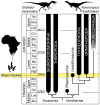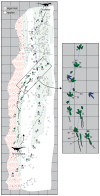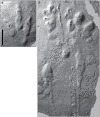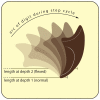Dynamic locomotor capabilities revealed by early dinosaur trackmakers from southern Africa
- PMID: 19806213
- PMCID: PMC2752196
- DOI: 10.1371/journal.pone.0007331
Dynamic locomotor capabilities revealed by early dinosaur trackmakers from southern Africa
Abstract
Background: A new investigation of the sedimentology and ichnology of the Early Jurassic Moyeni tracksite in Lesotho, southern Africa has yielded new insights into the behavior and locomotor dynamics of early dinosaurs.
Methodology/principal findings: The tracksite is an ancient point bar preserving a heterogeneous substrate of varied consistency and inclination that includes a ripple-marked riverbed, a bar slope, and a stable algal-matted bar top surface. Several basal ornithischian dinosaurs and a single theropod dinosaur crossed its surface within days or perhaps weeks of one another, but responded to substrate heterogeneity differently. Whereas the theropod trackmaker accommodated sloping and slippery surfaces by gripping the substrate with its pedal claws, the basal ornithischian trackmakers adjusted to the terrain by changing between quadrupedal and bipedal stance, wide and narrow gauge limb support (abduction range = 31 degrees ), and plantigrade and digitigrade foot posture.
Conclusions/significance: The locomotor adjustments coincide with changes in substrate consistency along the trackway and appear to reflect 'real time' responses to a complex terrain. It is proposed that these responses foreshadow important locomotor transformations characterizing the later evolution of the two main dinosaur lineages. Ornithischians, which shifted from bipedal to quadrupedal posture at least three times in their evolutionary history, are shown to have been capable of adopting both postures early in their evolutionary history. The substrate-gripping behavior demonstrated by the early theropod, in turn, is consistent with the hypothesized function of pedal claws in bird ancestors.
Conflict of interest statement
Figures





References
-
- Rogers RR, Swisher CC, III, Sereno PC, Monetta AM, Forster CA, et al. The Ischigualasto tetrapod assemblage (Late Triassic, Argentina) and 40Ar/39Ar dating of dinosaur origins. Science. 1993;260:1–4. - PubMed
-
- Sereno PC, Forster CA, Rogers RR, Monetta AM. Primitive dinosaur skeleton from Argentina and the early evolution of Dinosauria. Nature. 1993;361:64–66.
-
- Ellenberger P. Contribution à la classification des pistes de vertèbres du Trias: les types du Stormberg d'Afrique du Sud (II partie): le Stormberg Superieur-I. Le biome de la zone B/1 ou niveau de Moyeni: ses biocenoses. Paleovertebrata Mémoire Extraordinaire. 1974;1:1–202.
-
- Olsen PE, Galton PM. A review of the reptile and amphibian assemblages from the Stormberg of southern Africa, with special emphasis on the footprints and the age of the Stormberg. Paleontol Africana. 1984;25:87–110.
-
- Knoll F. Review of the tetrapod fauna of the “Lower Stromberg Group” of the main Karoo Basin (southern Africa): implication for the age of the Lower Elliot Formation. Bull Soc Géol France. 2004;175:73–83.
Publication types
MeSH terms
LinkOut - more resources
Full Text Sources

